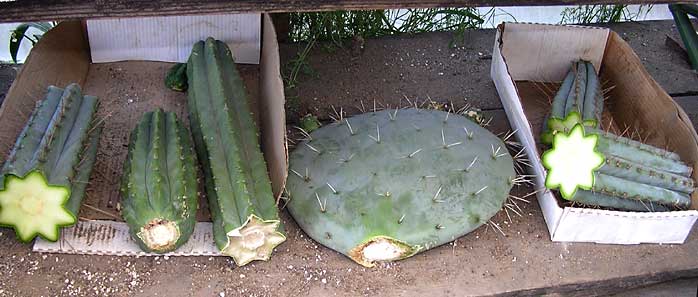Rooting Your Own Trichocereus Cactus Cuttings
If you would like soft plants, have a look at our Succulents!!!
Now comes the interesting component of having them to root, grow and flourish!
A good deal of different things play in the duration of time it takes for these men to start rooting. Time of year, soil type, place, and quantity of sun are factors to think about.
Trichocereus, such as the great majority of the rest of the plants, may root best in hot temps and hot soil. Obviously summer and spring would be the best seasons for having these men to develop, but inside where you are able to control these variables, will help you also.
So that your cutting/s have came. Occasionally we use just a tiny sulfur on the limit to aid with drying and also to shield it from any disease. The sulfur can turn a few colours, it is fine, just check to be certain that the finish is dry! When it’s, you are prepared to go to another step. If wet for some reason, keep dry let it sit in the colour for a couple of days, or perhaps prop it up so the finish faces the warm sunshine to help out. ** Be cautious though of leaving it straight on it’s side in sexy sustained sun because they may burn while in their sides.
In case the finish feels mushy/rotted (infrequently will this occur in transport ), you’ll have to decrease the rotted off section, be certain you cut to fine healthier cactus, you would like to eliminate whatever’s not healthy!
OK, you get a dry calloused cutting finish ready to plant. Soil is essential for any range of factors.
Wet, soggy dirt kills succulents and cactus over anything! If the soil is moist, it does not have to be watered!
Two, your dirt is equally the house of your tricho/cacti, and it is important source of nutrition! You have spent in such plants, invest a bit more and purchase/create an excellent dirt to your Tricho to flourish in. Consult your regional nursery/gardening centre for some simple cactus soil mix and you’re all set to go/grow, or create your own. Google to find out how! You may later add compost, worm castings, anything you wish to nourish your cactus together, however wait to do so until it is rooted and prepared to take from the meals!
Ok, so today you’ve got your dry cactus cut, a few appropriate dirt (does not have to be dry dirt, a little moisture isn’t just nice, not moist, you should not have the ability to squeeze out water ), a kettle with ***drainage holes***, and you will scoop out a couple of inches of dirt and gently put her into the ground, 2-3″ down is nice. In case you’ve got a heavy or lengthy cut, then you might want to support using a rod or something. Put in a dry and shady place for another 3-4 weeks since you await origins to start appearing. At this moment, it’s possible to carefully assess for root expansion by gently pulling your Tricho outside and inspecting, possibly she has begun, or you need to wait patiently for a couple weeks.
An alternate to Vertical planting is placing your Tricho horizontally on the floor or inside a huge pot if your cuts are little enough. The benefits of this is if you locate your Tricho pieces broken and on the floor (check for origins across the area facing the floor ), or in case you’ve got a large unsightly piece you would like simply to disperse out of. Planting vertically additionally provides more surface space for roots to form that ultimately, is going to be a big element in generating growth, in addition to expansion in a number of regions and it’s length!
If roots have started, now you can start watering lightly, and be certain that you await dirt to dry a little between each watering, recall, soggy sustained dirt kills cactus!
Your cactus are prepared for some complete sunlight, or you could experiment on their place. We’ve got cactus in total on hot baking sun that are flourishing if watered always, others who get little water when baking daily. Color and expansion have been caused by lack of water. In addition, we have many in partial shade, and a few giants which have grown tall and long upward over the sides of a trees, never getting full sunlight in any way. This is your decision in which you grow yoursbut if you find them bending/reaching for sunlight, you have to transfer them since this is not a fantastic thing. Additionally, SLOWLY ACCLIMATE your newly rooted Tricho into glowing, full, hot sunshine.
If you would like to propogate (begin new cuttings) out of your cactus, simply do as mentioned at the start. Just take a fresh knife or cut and saw a piece/pieces and allow dry and begin the cycle . You ought to receive multiple new hints forming on peak of the cut in a couple of weeks! If your plant falls over and pops, do not stress out, simply start over and become a new cuttingedge!
Occasionally trichos and other cactus will find a dark spot or place to the suggestion or and it’s side. Occasionally these are due to bruising, being calmed by additional cactus, etc.. Occasionally they simply appear. A great deal of forums discussing that, sometimes it looks like a tiny drip is coming from it that generally is dry to the touch. Do not panic! These black spots will probably become routine small scars in a couple of weeks/months and will grow as fresh expansion grows from the surface. The key here is knowing the difference between those black spots versus actual black rotted segments. Rotted cactus it is possible to push your finger . If your cactus becomes damaged over the side and does not heal properly, you’ll have to lower the lifeless section out.
Flowers!!! Your very first blossoms will look as little balls of white fur. These balls will turn into giant white/yellow blossoms that Bees and Hummingbirds will go insane over! Occasionally your Trichos will even create fruit and seed pods, which can be cool too!
Your Trichos should develop no less than a foot per year! Some could develop more, others less, obviously plenty of variables involved here! Various kinds of Trichocereus also grow differently in dimension and backbone length, in addition to colour and shape. Peruvian Torches have a lot of long spines. San Pedros change too, some reductions are fat logs, the others are skinnier. Both are alike!

